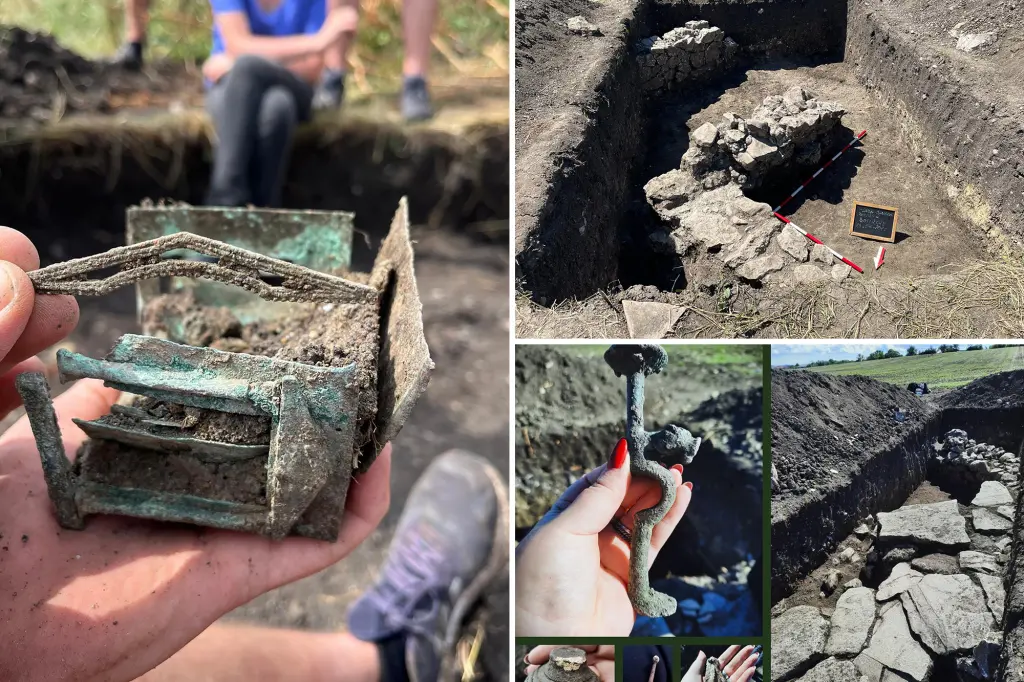Ancient Roman Temple Box Found in Romania: A Window into the Past
In a remarkable archaeological discovery, officials at the Turda History Museum in Romania announced in late September that they had unearthed a 1,700-year-old bronze box shaped like a temple. This exquisitely preserved artifact was found during summer excavations in Turda, a city that thrived as a civilian settlement under Roman rule from approximately the 1st century until the late 3rd century CE. Small enough to fit comfortably in the palm of a hand, the box’s pristine condition offers researchers an extraordinary glimpse into ancient Roman religious practices. With its distinctive temple façade, experts believe the box served important religious purposes for its original owner, connecting us directly to the spiritual life of Romania’s Roman past. This discovery not only adds to our understanding of ancient Roman material culture but also highlights the historical significance of this region that once formed part of the Roman Empire’s eastern frontier.
The temple box was unearthed during a carefully conducted archaeological excavation of multiple structures that once belonged to a Roman civilian, offering context that enhances our understanding of everyday life in ancient Dacia. The dig yielded numerous other artifacts that paint a vivid picture of Roman civilian life: coins that once changed hands in marketplace transactions, jewelry that adorned the wealthy, clothing accessories that fastened the togas and tunics of ancient residents, and decorative elements from furniture that once graced Roman homes. Together with the temple box, these items create a mosaic of daily life in Roman Dacia, allowing archaeologists to reconstruct not just the religious practices but also the economic activities, fashion trends, and interior design preferences of people who lived in this region nearly two millennia ago. Each artifact tells its own story, but collectively they narrate the broader cultural heritage of Turda and its significance within the Roman provincial network.
This archaeological site holds particular importance because of its location in what was once Dacia, a region coveted by Rome for its natural wealth. Eastern Europe’s ancient Dacia, encompassing modern-day Romania and surrounding areas, possessed rich deposits of salt and gold that caught the attention of ambitious Roman leaders, including Julius Caesar. The Romans recognized the strategic and economic value of these resources, which ultimately led to the region’s incorporation into the empire. The presence of such a finely crafted religious artifact in Turda demonstrates that this wasn’t simply a resource extraction zone for Rome, but a place where Roman culture, religion, and art flourished alongside economic activities. The temple box embodies the cultural synthesis that occurred as Roman traditions merged with local influences, creating a distinctive provincial identity within the broader Roman world.
The temple box’s religious significance cannot be overstated when considering ancient Roman society, where religious and civic life were deeply intertwined. This miniature temple likely served as a portable shrine or container for sacred items, allowing its owner to maintain religious practices even away from public temples. In Roman culture, such personal religious items reflected not only devotion but also social status, as finely crafted bronze items were not accessible to everyone. The box might have contained small votive offerings, incense for home rituals, or tiny figurines representing household gods that protected the family. Its temple design mirrors the architecture of larger Roman temples, complete with columns and pediments that would have been instantly recognizable to any Roman citizen as sacred space. This miniaturization of temple architecture demonstrates how deeply religious symbolism permeated all aspects of Roman material culture, from monumental public buildings down to personal possessions.
The excellent state of preservation of the temple box provides archaeologists with invaluable insights into Roman metallurgical techniques and artistic traditions. Bronze artifacts often deteriorate over centuries due to corrosion and environmental factors, yet this box has survived remarkably intact for over 1,700 years. This preservation suggests it may have been deliberately hidden or carefully stored, perhaps during times of unrest as Roman control over Dacia weakened in the 3rd century. The craftsmanship evident in the box reflects the high level of artistic skill present even in provincial areas of the Roman Empire, challenging earlier assumptions that fine metalwork was produced only in major urban centers. The detailed temple façade would have required sophisticated casting techniques and careful finishing work, indicating that skilled artisans were active in or trading with this Dacian settlement. Further analysis of the bronze composition might reveal whether the box was locally produced or imported from elsewhere in the empire, shedding light on trade networks and cultural exchange.
This discovery adds another chapter to the rich archaeological narrative of Romania, a country whose soil continues to yield evidence of its diverse cultural heritage spanning millennia. From Dacian treasures to Roman settlements, Byzantine influences to medieval fortifications, Romania’s archaeological wealth reflects its position at the crossroads of Eastern and Western civilizations. The temple box from Turda reminds us that even small artifacts can illuminate vast historical processes, connecting us to individuals who lived, worked, and worshipped in these lands long ago. As museum officials prepare to study, preserve, and eventually display this remarkable find, it will join other archaeological treasures that collectively tell the story of Romania’s pivotal role in European history. For visitors to the Turda History Museum, this palm-sized temple will offer a tangible connection to an empire that once stretched from Britain to the Middle East, and to the anonymous Roman civilian who once held this sacred object in their hands, participating in religious rituals that gave meaning and structure to life in ancient Dacia.


